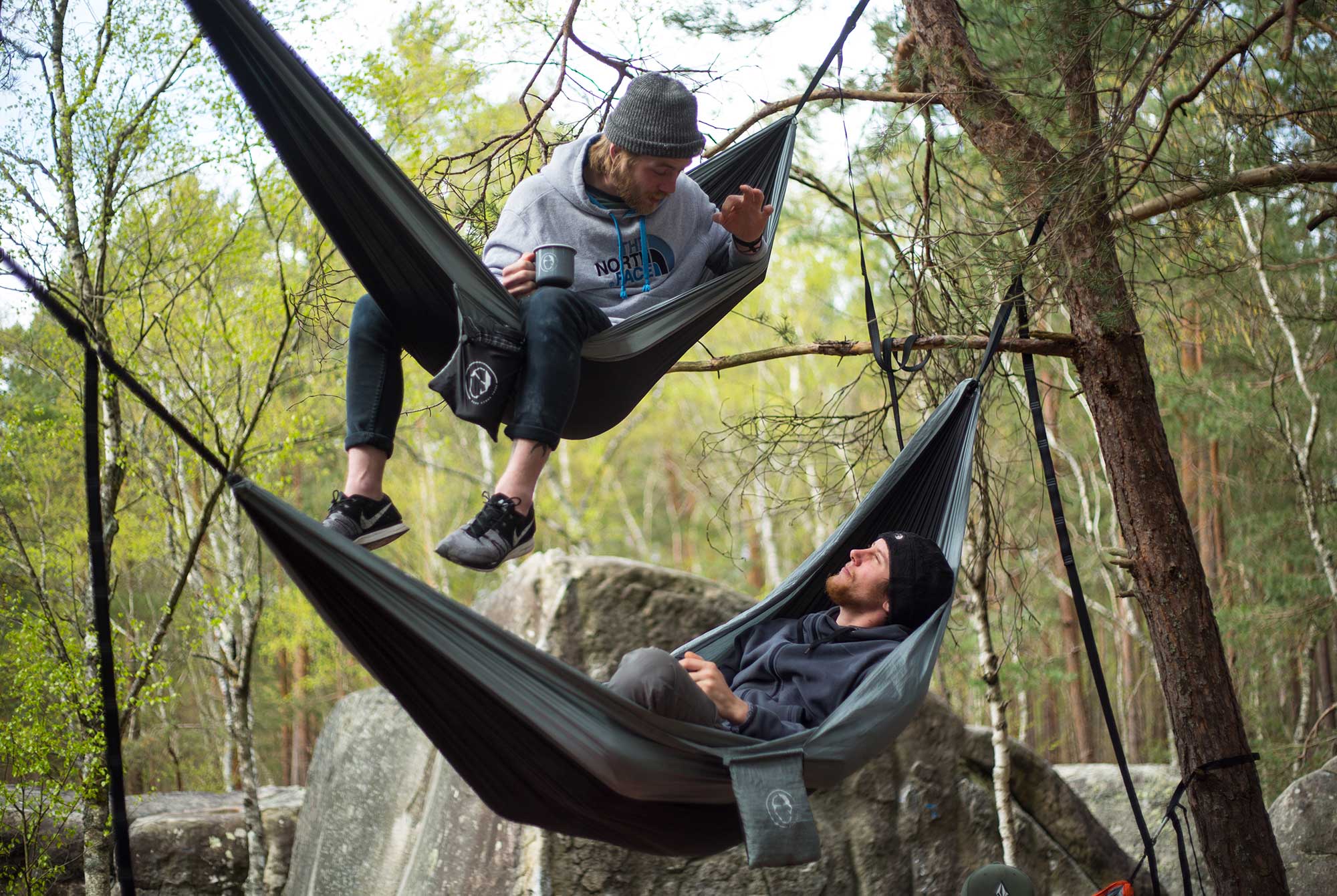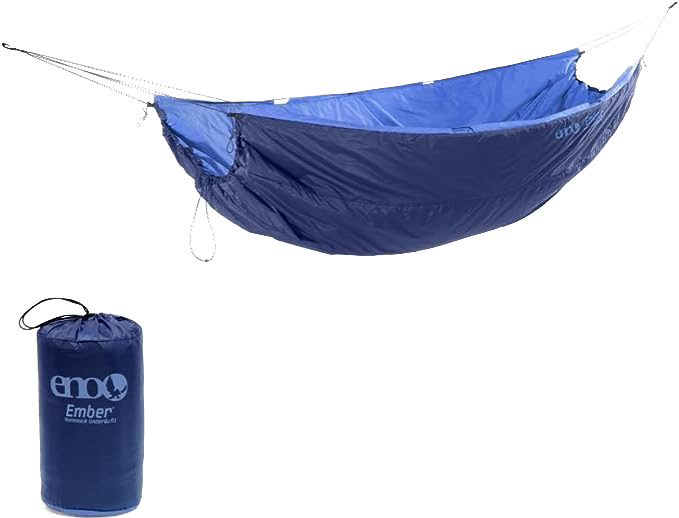Have you ever wanted to hammock outdoors with friends or family but found yourself limited by the number of available trees? Learning “how to hammock stack” might be the solution you’ve been seeking! This innovative approach allows you to hang multiple hammocks between just two trees, creating a cozy and space-saving setup. In this blog post, we’ll guide you through the basics of creating a ladder with multiple hammocks and provide tips for a safe and comfortable experience.
Short Summary
- Find two sturdy trees with a diameter of 12″ or more.
- Hang the bottom hammock first 2′ to 3′ above the ground
- Hang a second hammock 3′ to 4′ above the first one.
- Repeat the process for all hammocks
- Relax and enjoy hammocking with others!
Disclaimer: Is it safe to stack hammocks?
There are safety concerns when it comes to hammock stacking and opinions are divided. Some argue that stacking hammocks one above another is extremely dangerous as one person could fall out from a tall height and even land on others below. Several user manuals for hammocks cite liability concerns and that it is not safe to hammock stack – doing so is at your own risk.
Additionally, there is a risk of damaging the trees if the weight is too great for them to support. If the trunk or branch breaks the hammock and the hammock goer will certainly fall to the ground below.
If you do decide to hammock stack, take extra caution to secure your anchor points and ensure that the trees you’re stacking hammocks from can support the combined weight and stress. Without taking these precautions, severe injuries can result from elevated falls.
The Basics of Hammock Stacking

Hammock stacking refers to the practice of utilizing the same two trees to hang multiple hammocks, positioning them one above the other like a bunk bed system. This unique arrangement can be a fun and space-saving alternative to traditional tent camping, especially when you’re in the woods with limited tree options.
But before you start stacking hammocks, there are some important factors to consider, such as the risk of serious injury from a fall and the effect your combined weight can have on the trees.
Selecting the right trees is one of the first steps in creating a secure hammock stack. Look for trees with a minimum diameter of two feet, healthy and sturdy, and avoid those with sensitive plant life or dead branches. The size, age, and health of the trees will determine how many hammocks you’ll be able to hang. The recommended tree distance for hammock stacking is between 12-15 feet apart, ensuring that the straps are of the same length for a balanced setup.
Lastly, try to pick a place where it’s flat and avoid rocky ground. Not to say that anyone is going to fall out, but it doesn’t hurt to have soft ground below.
Note: Check with your local land managers to ensure you have permission and will be safe hammocking in the local area.
Setting Up Your Hammock Ladder

Now that you’re familiar with the basics of hammock stacking and found a good pair of trees or solid branches to anchor from, let’s dive into the step-by-step process of setting up your very own hammock stack.
Hanging the First Hammock
Hanging the first hammock in the stack is the easiest. Essentially, you’ll hang it like you would most hammocks. Hammocks should also be the same length and size.
So you’ve selected your spot and are ready to set up. Make sure the two trees are spaced 10-14 feet apart. Wrap one of the hammock straps around one tree and feed the end through the loop, pulling it tight. Position the strap at a 30-degree angle relative to the ground, which will provide optimal support and comfort for your hammock.
Note: For hammocking arrangements, I highly recommend having the heaviest person in the lowest hammock. This is where the trees’ supports will be strongest and there’s a lot lower chance of injury.
Adding Additional Hammocks
Next step, adding more hammocks. When adding another hammock to your stack, you’ll anchor your hammock straps 3 to 4 feet higher than the lower hammock on the same two trees. You’ll continue to add the hammock straps adding one hammock at a time.
I recommend using a ladder to tie the higher-up hammock straps rather than sitting in your hammock to do it. It can be a little tricky trying to balance in a hammock while trying to securely tie things off. Compound that with the risk of falling at a higher distance. Overall, it’ll be much easier and safer just using a ladder or stool rather than the hammock ladder.
Also, remember to always check the secure fastening and verification of all knots before entering any hammock in your stack.
Note that your anchor points on the tree should have a diameter of more than 8 inches. This should give you enough support for that particular hammock. The higher up the tree you go, the thinner the trunk and branches become. I highly recommend you don’t go higher if the anchor points for your hammock straps do not meet the 8-inch diameter requirement. This could be too much weight for the trees and cause them to break, thus dropping you and your hammocks.
Adjusting Hammock Length
Each person is different and sometimes needs to adjust their hammock to be more comfortable. Start with the bottom hammock and work up from there. You may need to adjust the length or tension of the hammocks. You can do this by changing the distance between the two anchor points located at the points where the hammock is connected to the hammock straps.
If you’re using a strap that has multiple anchor points, this will be as simple as picking a new point. If not, you may need to retire the strap completely. Again, I recommend using a ladder or stool to have something solid to stand on while you make the adjustments. Be sure to try out the hammock and make sure everything feels good before moving on to the next hammock.
Getting In and Out of Stacked Hammocks
Getting in and out of stacked hammocks can be a bit tricky, especially for those not accustomed to climbing or being in elevated sleeping positions. In this section, we’ll provide helpful tips for entering and exiting stacked hammocks with ease and safety in mind.
Starting with the safest and easiest option – use a ladder. If you used a ladder to set up the hammocks, I recommend just leaving it up and having people use it to get in and out of the hammocks. This makes it easy if anyone in the higher hammocks needs to get out but doesn’t want to bother anyone below.
If you don’t have access to a ladder you can climb up into each hammock one at a time. As you can imagine, the person in the top hammock will need to be the first one to get in and the last person to get out of their hammock.
To start, get in the bottom hammock. Once you’re in reach up and grab the hammock above you. Tuck your arms and legs in the sides of the hammock above and then pelvic thrust and roll. This momentum should cause you to turn over and be in the hammock above. You will need to repeat this process until you’re in the desired hammock.
Keep in mind that safety is always a priority, so be sure to check all knots and connections before attempting to enter or exit any hammock in the stack.
Exiting Stacked Hammocks
Exiting stacked hammocks can be a bit more challenging, but with proper technique, it can be done safely and efficiently.
To go down to the lower hammock, first, tuck your arms and feet into your current hammock. Make sure you are tight and secure. Next, turn your head and shoulders in one direction, and the hammock should roll. At this point, you should be faced upside down and see the hammock below you. Slowly reach out your leg and gently lower yourself into the hammock. Continue these steps until you reach the bottom hammock – at which point you can just get out onto the ground.
When entering or exiting a hammock, always be mindful of other occupants in the stack and be careful not to tip anyone over or throw off their balance.
How to Be Comfortable in Stack Hammocks

By now, you’re an expert in setting up a hammock ladder and can easily get in and out of a hammock.
However, if you plan to stay in your hammock for a while you’ll want to take some additional steps to be comfortable. This can include laying positions of hammocks, bringing additional gear, and planning for the weather. Follow these tips and ensure a safe and enjoyable experience for all.
How to Lay Comfortably in Hammocks
To optimize comfort in your hammock stack, hang the hammock with a good sag, lay diagonally across the hammock, and raise the foot end higher. Additionally, maintain a 30-degree strap angle between the strap and the ground for optimal support and comfort. Try using spacer bars on your hammock to lay flatter and comfortably.
When arranging campers in a hammock stack, I recommend having each person sleeping in the opposite direction as the person above and below them. This will provide better weight distribution on the tree and be more comfortable for all occupants.
Read more: Is it safe to sleep in a hammock?
Plan For Weather Ahead of Time
Watching the weather forecast and planning is critical for being safe when you stack hammocks.
Do NOT stack hammocks if there’s a thunderstorm or rain on the horizon. It’s difficult to get out of a stacked hammock. But when it rains the tree, hammocks and straps will all be slippery. Add in the threat of lightning and you have the perfect combination for someone to get hurt.
Read more: Are Hammocks Safe in Lightning Storms?
Additionally, to watch for incoming storms, you should plan to accommodate with local temperature. If the weather is forecasting chillier weather, I recommend utilizing an underquilt, sleeping pad, and even a sleeping bag within the hammock. These accessories will help insulate your hammock and keep you warm. If you’re planning on sleeping overnight, this additional layer of support can support your back and relieve pressure along your body.
Pay attention to poisonous plants and wildlife
One thing to mention when hammocking is to be mindful of any poisonous plants or wildlife. Depending on your area, poison oak or poison ivy can be common. Follow this guide from the FDA if you come into contact with poisonous plants.
Other Types of hammocking for groups
Rather than create a hammock stack with your group, try one of these alternatives.
Hammock Bunk Bed Concept
The hammock bunk bed concept involves arranging two hammocks in a stacked manner between two trees, creating a vertical sleeping arrangement. This can be an exciting alternative to traditional camping setups, especially when you’re in the woods with limited tree options.
Similarly to what was mentioned above, be sure to anchor from healthy trees and solid branches. Try to avoid putting too much weight on a skinny tree that can’t support the weight.
Use a Hammock Triangle to Hang multiple hammocks
If you have three trees near each other, you can set up a hammock triangle. This is where you form a triangle of hammocks by anchoring 3 hammocks from 3 trees. This is a great option if you’re trying to hang multiple hammocks but don’t want to stack or be closer to one another.
Summary
In conclusion, hammock stacking can be a fun and space-saving solution for enjoying the great outdoors with friends or family. By understanding the basics of hammock stacking, following a step-by-step setup process, and adhering to safety guidelines, you can create a comfortable and secure hammock stack experience. So, the next time you head into the woods with limited tree options, consider trying out hammock stacking as an alternative to traditional tent camping. Happy stacking!



 Hello there, we're Vira Outdoors!
Hello there, we're Vira Outdoors!

